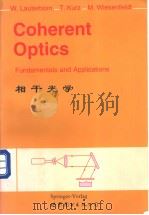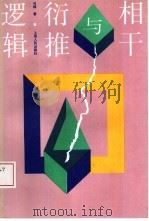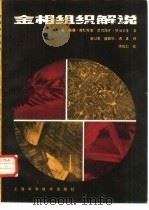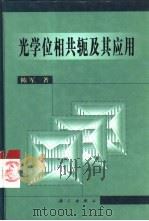《相干光学》
| 作者 | W.LAUTERBORN,T.KURZ,M.WIESENFE 编者 |
|---|---|
| 出版 | 北京/西安:世界图书出版公司 |
| 参考页数 | 294 |
| 出版时间 | 1998(求助前请核对) 目录预览 |
| ISBN号 | 无 — 求助条款 |
| PDF编号 | 81402038(仅供预览,未存储实际文件) |
| 求助格式 | 扫描PDF(若分多册发行,每次仅能受理1册) |

1History of Optics1
1.1 Past1
1.2 Present5
1.3 Future7
Problems8
2The Main Areas of Optics9
2.1 Geometrical Optics9
2.2 Wave Optics10
2.3 Quantum Optics11
2.4 Statistical Optics12
3Fundamentals of Wave Optics15
3.1 Maxwell's Equations15
3.2 The Wave Equation17
3.3Wayes18
3.3.1 One-Dimensional Waves18
3.3.2 Plane Waves21
3.3.3 Spherical Waves22
3.3.4 Bessel Waves23
3.4 Intensity of a Light Wave25
Problems28
4Coherence31
4.1 Temporal Coherence31
4.2 Spatial Coherence39
4.3 Spatiotemporal Coherence46
4.4 Complex Representation of the Light Field48
4.5 Stellar Interferometry49
4.6 Fourier Spectroscopy51
4.7 Intensity Correlation53
Problems55
5Multiple-Beam Interference59
5.1 Fabry-Perot Interferometer59
5.2Mode Spectrum ofa Laser66
5.2.1 Interference Spectroscopy67
5.2.2 Difference-Frequency Analysis69
5.3 Dual-Recycling Interferometer71
Problems73
6Speckles75
6.1 Intensity Statistics76
6.2 Speckle Sizes78
6.3Speckle Photography82
6.3.1 Double-Exposure Technique84
6.3.2 Time-Average Technique87
6.4 Flow Diagnostics90
6.5 Stellar Speckle Interferometry93
Problems96
7Holography99
7.1Principle of Holography99
7.1.1 Hologram Recording100
7.1.2 Image Reconstruction102
7.1.3 Location of the Images104
7.1.4 Phase Conjugation106
7.2 The Imaging Equations of Holography108
7.3Holographic Arrangements112
7.3.1 In-line Holograms112
7.3.2 Reflection Holograms113
7.3.3 Transmission Holograms114
7.3.4 White-Light Holograms116
7.3.5 Rainbow Holograms118
7.3.6 Holographic Cinematography120
7.4Digital Holography120
7.4.1 Direct Simulation121
7.4.2 Simulation with Square Light Waves128
Problems130
8Interferometry133
8.1 Mach-Zehnder Interferometer133
8.2 Sagnac Interferometer134
8.3Holographic Interferometry138
8.3.1 Real-Time Method138
8.3.2 Double-Exposure Method138
8.3.3 Time-Average Method140
8.4Theory of Holographic Interferometry140
8.4.1 Real-Time and Double-Exposure Method140
8.4.2 Time-Average Method142
8.4.3 Time-Average Method in Real Time143
Problems145
9Fourier Optics147
9.1Scalar Diffraction Theory147
9.1.1 Fresnel Approximation148
9.1.2 Fraunhofer Approximation150
9.2 Fourier Transform by a Lens152
9.3Optical Fourier Spectra153
9.3.1 Point Source154
9.3.2 Plane Wave154
9.3.3 Infinitely Long Slit155
9.3.4 Two Point Sources158
9.3.5 Cosine Grating158
9.3.6 Circular Aperture160
9.3.7 Compound Diffracting Systems162
9.4Coherent Optical Filtering164
9.4.1 Low-Pass Filter or Spatial Frequency Filter165
9.4.2 High-Pass Filter or Dark Field Method166
9.4.3 Phase Filter or Phase Contrast Method168
9.4.4 Half-Plane Filter or Schlieren Method169
9.4.5 Raster Elimination170
9.4.6 Demonstration Experiment171
9.4.7 Holographic Filters172
9.4.8 Pattern Recognition174
Problems177
10Nonlinear Dynamics of the Laser179
10.1 The Laser Principle179
10.2 Laser Rate Equations181
10.3 Stationary Operation185
10.4 Stability Analysis186
10.5 Chaotic Dynamics191
Problems197
11Nonlinear Optics199
11.1Two-Wave Interaction199
11.1.1 Two-Photon Absorption200
11.1.2 Two-Photon Ionization201
11.2Three-Wave Interaction202
11.2.1 Second-Harmonic Generation202
11.2.2 Sum-Frequency Generation202
11.2.3 Difference-Frequency Generation203
11.2.4 Optical Parametric Amplifier204
11.3 Four-Wave Interaction204
11.4Multi-photon Interaction205
11.4.1 Frequency Multiplication205
11.4.2 Multi-photon Absorption and Ionization206
11.5 Further Nonlinear Optical Phenomena207
11.6 Nonlinear Potentials208
11.7Interaction of Light Waves210
11.7.1 Three-Wave Interaction212
11.7.2 Scalar Three-Wave Interaction218
11.7.3 Second-Harmonic Generation219
11.7.4 Optical Parametric Amplifier222
11.7.5 Optical Parametric Oscillator223
11.7.6 Three-Wave Interaction in the Photon Picture224
Problems226
12Fiber Optics229
12.1Glass Fibers230
12.1.1 Profile230
12.1.2 Guided Waves231
12.1.3 Attenuation233
12.2 Fiber Sensors235
12.3Optical Solitons236
12.3.1 Dispersion237
12.3.2 Nonlinearity241
12.4 Fiber-Optic Signal Processing245
Problems246
AAppendix249
A.1The Fourier Transform249
A.1.1 One-Dimensional Fourier Transform249
A.1.2 Two-Dimensional Fourier Transform250
A.1.3 Convolution and Autocorrelation251
A.1.4 Properties of the Fourier Transform252
A.1.5 Selected Functions and Their Fourier Transforms254
Problems254
A.2 Solutions to Problems257
Index281
1998《相干光学》由于是年代较久的资料都绝版了,几乎不可能购买到实物。如果大家为了学习确实需要,可向博主求助其电子版PDF文件(由W.LAUTERBORN,T.KURZ,M.WIESENFE 1998 北京/西安:世界图书出版公司 出版的版本) 。对合法合规的求助,我会当即受理并将下载地址发送给你。
高度相关资料
-

- 光干涉测量技术
- 1995 北京:中国计量出版社
-

- 衍射光学中的相干性
- 1974年08月第1版 科学出版社
-

- 照相感光材料
- 五洲出版社
-

- 相声 一扫光
- 太原:山西人民出版社
-

- 干部相关知识讲座
- 中共辽宁省委党校
-

- 相干光学 Coherent Optics
- 1998 世界图书出版公司北京公司
-

- 光学金相技术
- 1992 北京:北京航空航天大学出版社
-

- 光学计和接触式干涉仪
- 1981 北京:机械工业出版社
-

- 相干与衍推逻辑
- 1993 上海:上海人民出版社
-

- 激光干涉量度学
- 1988 北京:科学出版社
-

- 金相组织解说
- 1984 上海:上海科学技术出版社
-

- 光学金相摄影技术
- 1983 北京:科学出版社
-

- 系统论控制论信息论与哲学
- 1988 长沙:中南工业大学出版社
-

- 光学位相共轭及其应用
- 1999 北京:科学出版社
提示:百度云已更名为百度网盘(百度盘),天翼云盘、微盘下载地址……暂未提供。➥ PDF文字可复制化或转WORD
